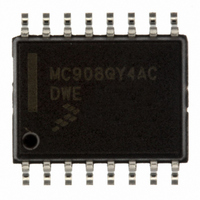MC908QY4ACDWE Freescale Semiconductor, MC908QY4ACDWE Datasheet - Page 196

MC908QY4ACDWE
Manufacturer Part Number
MC908QY4ACDWE
Description
IC MCU 8BIT 4K FLASH 16-SOIC
Manufacturer
Freescale Semiconductor
Series
HC08r
Datasheet
1.MC908QT1ACDWE.pdf
(200 pages)
Specifications of MC908QY4ACDWE
Core Processor
HC08
Core Size
8-Bit
Speed
8MHz
Peripherals
LVD, POR, PWM
Number Of I /o
13
Program Memory Size
4KB (4K x 8)
Program Memory Type
FLASH
Ram Size
128 x 8
Voltage - Supply (vcc/vdd)
2.7 V ~ 5.5 V
Data Converters
A/D 6x10b
Oscillator Type
Internal
Operating Temperature
-40°C ~ 85°C
Package / Case
16-SOIC (0.300", 7.5mm Width)
Processor Series
HC08QY
Core
HC08
Data Bus Width
8 bit
Data Ram Size
128 B
Maximum Clock Frequency
8 MHz
Number Of Programmable I/os
13
Number Of Timers
2
Maximum Operating Temperature
+ 85 C
Mounting Style
SMD/SMT
Development Tools By Supplier
FSICEBASE, M68CBL05AE, DEMO908QB8, DEMO908QC16
Minimum Operating Temperature
- 40 C
On-chip Adc
10 bit, 6 Channel
Lead Free Status / RoHS Status
Lead free / RoHS Compliant
Eeprom Size
-
Connectivity
-
Lead Free Status / Rohs Status
Details
Available stocks
Company
Part Number
Manufacturer
Quantity
Price
Part Number:
MC908QY4ACDWE
Manufacturer:
FREESCALE
Quantity:
20 000
Part Number:
MC908QY4ACDWER
Manufacturer:
FREESCALE
Quantity:
20 000
A.3 Conversion Considerations
Enhancements lead to slight differences in operation from QYx Classic to the QYxA. There are a few
points that should be considered in the conversion process.
A.4 Code Changes Checklist
Below is a checklist that should be reviewed in the conversion process. This checklist will point out all the
issues that should be addressed as your code is ported.
196
1. Does the original software use Auxiliary ROM routines (for example, Getbyte, Putbyte, delnus)?
2. Does the software use FLASH as EEPROM?
3. Does the code use the auto wake up timer and does the application depend on the typical auto
4. Bits changed in the OSCSC, CONFIG2, and ADC registers?
5. Does the code use external OSC, crystal, or RC?
6. Does the code use the ADC?
•
•
•
The Monitor ROM changed from 2 K to 1 K in size. This has led to the limitation that programming
across page boundaries is no longer supported by the on-chip program range routine. Also, in very
rare cases, ROM code improvements could cause customers to have to modify a few instructions
in their application code. For example, when performing a mass erase, a valid address is required
instead of an unspecified address.
The QYxA contains new modules like the 10-bit ADC and OSC. In rare cases, new modules could
cause customers to have to modify a few instructions in their application code. For example, if ADC
code was written so that entire registers are configured without respect to reserve bits, then the
ADC code will need to be revised to work correctly on the QYxA.
The Reference Clock for ADC conversions has changed from the bus clock to the system clock
(Bus Clock * 4). A change to the divide register may be necessary to set the reference clock to a
specified value.
If so, the software will have to be changed to handle new Auxiliary ROM routines, addresses of
these routines have changed in QYxA. Code will have to be changed to use the proper addresses.
If so, there are several possible issues for the page erase and mass erase routine. Software will
have to be checked to ensure that proper procedure is used and the CTRLBYT is set with a MOV
instruction not a BSET. Also, on-chip FLASH programming routines can no longer program across
row boundaries
wake time out?
Since the timeout has been improved for QYxA it may be necessary to modify software to
compensate for the change in timeout.
Any code that writes to these registers should be reviewed to ensure that the writes are not
affecting the changed bits
If so, since the OSCOPT bits have changed locations code will have to be updated to update these
bits in their proper locations.
If so, because on QYxA the ADC clock is driven from 4XBUSCLK instead of BUSCLK changes to
the ADC clock divider bits may be needed to maintain proper operation.
MC68HC908QYA/QTA Family Data Sheet, Rev. 3
Freescale Semiconductor











